Middle Arm senate inquiry hears water trigger unlikely to apply to Tamboran’s Beetaloo project
The Environment Department has ‘utterly betrayed’ Territorians by confirming it will not recommend expanded water protection laws be applied to Tamboran’s Beetaloo project, activists say.
Politics
Don't miss out on the headlines from Politics. Followed categories will be added to My News.
The federal Environment Department has “utterly betrayed” Territorians by confirming it will not recommend expanded water protection laws be applied to Tamboran’s Beetaloo project, environmentalists say.
Senior department officials told the Middle Arm senate inquiry that they would not recommend Environment Minister Tanya Plibersek call in Tamboran’s Shenandoah South fracking project under the water trigger.
The NT government approved the project earlier this month, marking the final environmental check needed unless water trigger laws were to be applied.
Central Australian Frack Free Alliance said Labor was breaking an election promise, pointing to a corflute hung at Lingiari MP Marion Scrymgour’s polling booth at the last federal election: “A federal Labor government will establish a Commonwealth EPA to ensure that the water trigger (extended to shale gas projects) is applied independently and without delegation,” it reads.
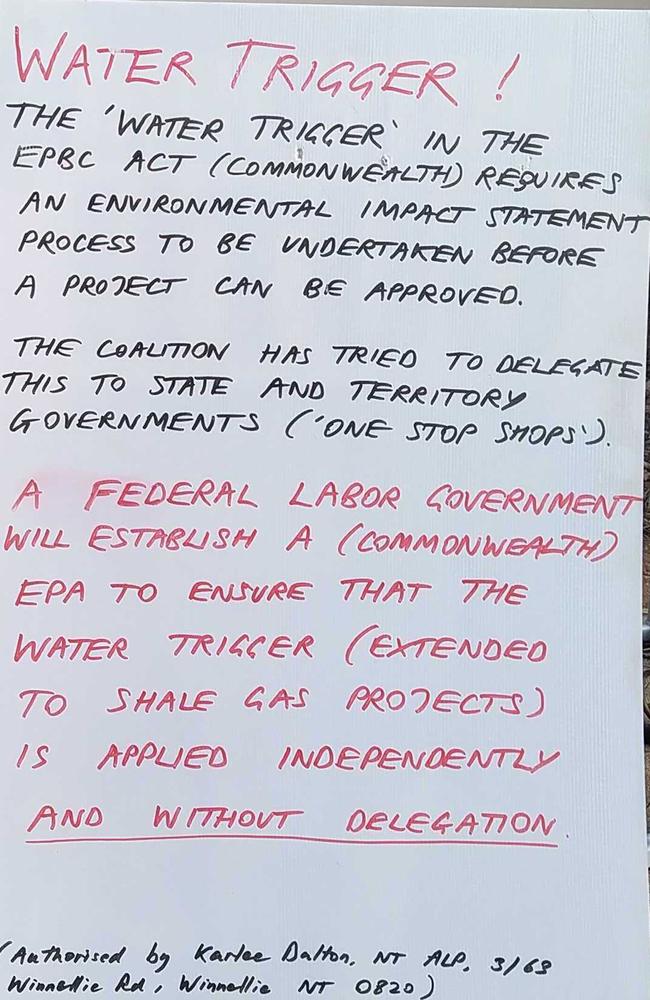
CAFFA spokesperson Hannah Ekin said: “If there is a contamination event, if bores lose water and pressure, or springs dry up as a result of this project, it will be the Albanese government we hold just as responsible as Tamboran, because they had this law and they failed to use it.”
“Territorians have consistently demanded better scrutiny of fracking’s impacts on water and are bitterly disappointed that our federal representatives … have not been able to deliver on that.”
Lock the Gate Alliance national co-ordinator Carmel Flint said if a similar project was taking place in other states “we have no doubt that it would be referred for proper assessment at the federal level”.
“One billion litres of groundwater will be drained so Tamboran can frack its 15 gas wells, almost every drop of that water will be contaminated with chemicals and sent down fracking wells,” she said.
“For the Environment Minister’s department to leave this project unscrutinised by the newly expanded water trigger is an utter betrayal of Territorians who put their faith in her government at the last election, and in December when this law was passed.”
Under current processes companies are required to refer their own project for assessment under the Environment Protection and Biodiversity Conservation Act (which includes the water trigger) if it risks “significant harm” to “matters of national environmental significance”; a threshold Tamboran has not met for its Beetaloo development.
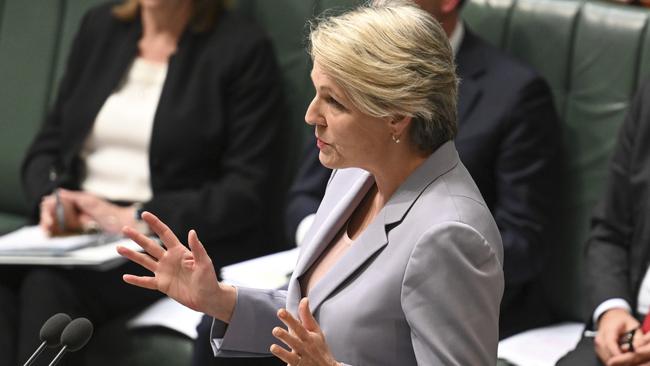
“No projects for unconventional gas exploration, appraisal or production in the Beetaloo Basin have been referred to the department for assessment under national environment law,” an Environment Department spokesman said.
“Anyone proposing an action must refer their project to the department for environmental assessment if there is a potential of significant risk of harm to matters of national environmental significance.
“The department has notified relevant companies in the Beetaloo Basin of this obligation.”
He said the department had met with Tamboran to discuss its obligations, and understood the company had a “comprehensive”environmental management plan approved by the NT EPA.
“The department will continue to work with Tamboran as they develop work plans, so that any potentially significant impacts can be appropriately identified which would then require them to refer it to the department.”
Ms Scrymgour has been contacted for comment.
NT environment watchdog under fire at Middle Arm inquiry
June 17: The chair of a federal senate inquiry into the Territory’s proposed $1.5bn Middle Arm industrial precinct said it was ‘disturbing’ to learn the local environmental watchdog was not actively monitoring all toxic chemicals emitted during gas production.
Greens Senator and inquiry chair Sarah Hanson-Young said Darwin’s air quality was not being adequately regulated by the Northern Territory Environment Protection Authority.
Her comments followed concern raised during public hearings in Canberra on Monday about volatile organic compounds – a toxic by-product of gas production – being released by Inpex’s Ichthys LNG gas facility on Darwin Harbour at rates up to 22 times higher than initial estimates.
The EPA is not proactively monitoring levels of volatile organic compounds in the NT, the committee heard, nor pursuing Inpex for underestimating its pollution, arguing air quality remained well within healthy limits.
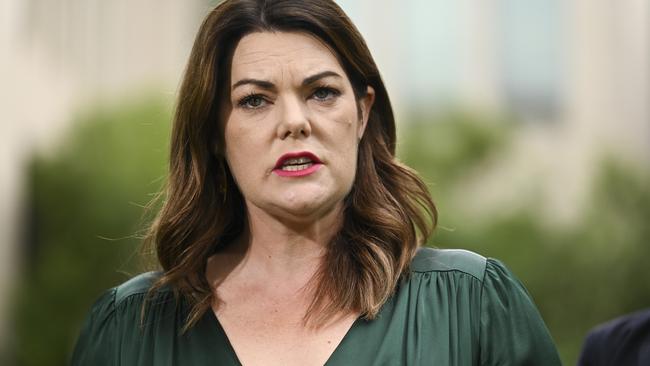
“It’s time that the local Darwin community were listened to by representatives here in Canberra, they don’t want this toxic gas hub,” Ms Hanson-Young said.
“They prefer it to be focused on clean, renewable energy. They don’t want any more toxins being pushed into the Darwin air, because already we know the Darwin community suffer some of the worst air quality in the country.
“And it’s not being regulated properly by the EPA … it’s pretty disturbing that the EPA is not already monitoring the levels of pollutants and toxins that have been pumped into the air in Darwin, and yet are at the table about to sign off on expanding this type of pollution even further.”
Chief Minister Eva Lawler said most of the NT’s poor quality was due to bushfires and fire management, suggesting recent concern about volatile organic compounds was anti-development scaremongering.
“The Northern Territory government wants to make sure our environment is absolutely as pristine as we can have our environment.
“Some of our highest emissions that we see are caused by our bush burning across the Northern Territory, and that has been the case for a long time.
“If there doesn’t need to be additional monitoring that will be put in place – that will be the process through the environment management plans (and) assessment that’s done with any of the proponents that go into Middle Arm.
“We want to see Middle Arm as a project up and running and providing jobs for Territorians.”
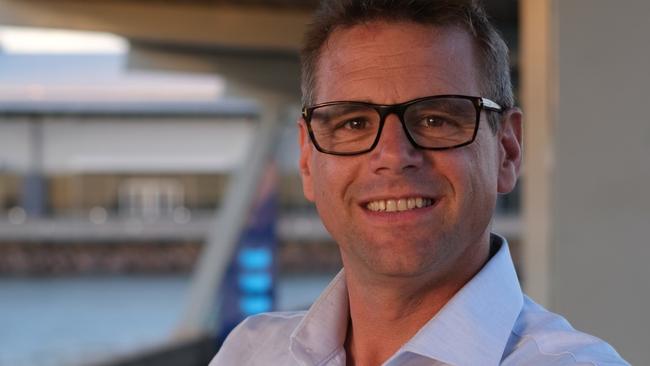
Monday’s inquiry hearings included several gas proponents, including peak body Australian Energy Producers.
NT director David Slama said the discussions were “very productive”.
“I’m sort of staggered to see the misinformation that’s out there, and I’m glad they had the opportunity to represent and provide some of the reality of what is happening and what is going on, rather than misrepresented information coming through,” he said.
He said much of the senate probe was repeating thousands of hearings and submissions covered by the Pepper fracking inquiry.
“It was a good opportunity just to highlight in Canberra the rigour through which the Northern Territory government has put industry in its development phase, particularly around the Beetaloo.
“Middle Arm has been earmarked for the last 20, 30 years as the place to develop the Territory, provide jobs for Territorians.
“I’m glad to see finally that there’s a good healthy dialogue happening around how that can be done safely, environmentally friendly, and appropriately, but also, we need to get on with it.”
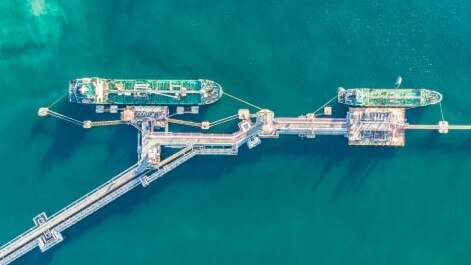
NT Greens candidate Suki Dorras-Walker said Monday’s hearings revealed “that Middle Arm doesn’t stack up economically and our taxpayer dollars are being funnelled into a failing industry”.
“Our government is propping up the pipe dreams and profits of gas corporations at the expense of our health, climate, water and economic welfare.”
The NT EPA has been contacted for comment.
Gas industry to front Middle Arm public hearings in Canberra
June 17: Public hearings into the Territory’s proposed $1.5bn Middle Arm industrial precinct will be held in Canberra this week, with a line up of gas industry executives set to defend the development to federal parliament.
Tamboran Resources is scheduled to appear first in the two days of hearings, beginning on Monday, as part of an ongoing senate inquiry into Middle Arm.
Other Middle Arm proponents TE H2 and Tivan will also front the committee, alongside several major industry players in the NT, including Santos, SunCable, Empire Energy, and Inpex.
It comes after public hearings held in Darwin in April were criticised for leaving pro-development stakeholders off the line up.
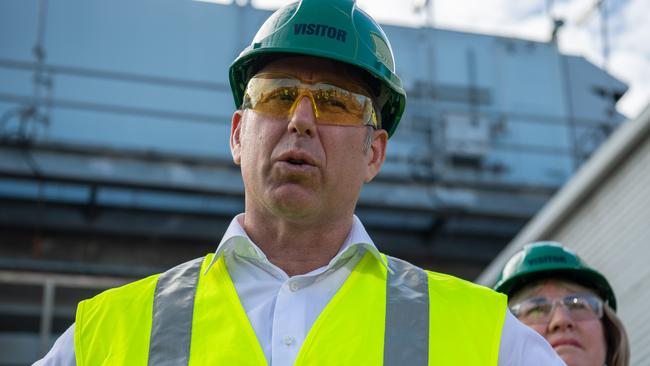
In its submission Tamboran argued the growing risk of gas supply shortfalls in both domestic and global markets was “having a material impact on the cost of living for Australian families”.
“Without government investment and support to encourage investment in the gas sector, Australian households and businesses could face increased blackouts and supply disruptions,” it said.
“This will not only hurt ordinary Australians and businesses, but also poses a significant security risk to the Australian government.”
Tamboran has inked a “not to deal” agreement with the government to develop a gas export facility at Middle Arm.
Tamboran said gas from the Beetaloo – one step closer after the NT government this month granted the company final environmental approval – would offer a “dependable route for Australia’s energy transition”.
“Tamboran’s project is poised to significantly contribute to the Australian government’s goal of achieving net zero emissions by 2050 and meeting its commitments under the Paris Agreement.”
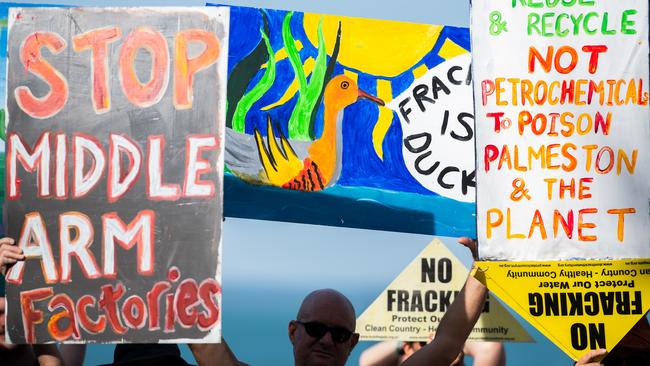
Several government agencies and environmental organisations will also front the senate inquiry this week.
Among them is policy group Climate Analytics, whose research, commissioned by Nurrdalinji Aboriginal Corporation, found emissions from Middle Arm and the Beetaloo had been “wildly underestimated”.
It estimated Tamboran’s Middle Arm gas facility would, in the first part of the project, generate domestic life cycle emissions equivalent to adding six to eight million new cars to Australian roads, and that overall emissions would be more than 50 per cent higher than the nation’s total 2021 emissions.
“Both the proposed Middle Arm gas hub and fracking the Beetaloo Basin would produce a massive increase in emissions, which can’t be offset,” report author Thomas Houlie said.
“The IPCC makes it clear that existing fossil fuel infrastructure is setting us on track to exceed the remaining 1.5°C compatible carbon budget, an objective the Australian government committed to by signing the Paris Agreement.
“The International Energy Agency also shows that no new upstream oil and gas projects are needed to meet demand in a scenario that aligns with the 1.5°C goal.”
The Middle Arm senate inquiry was launched in September and was originally due to wrap up in February, but after multiple extensions the report is now due August 13.





